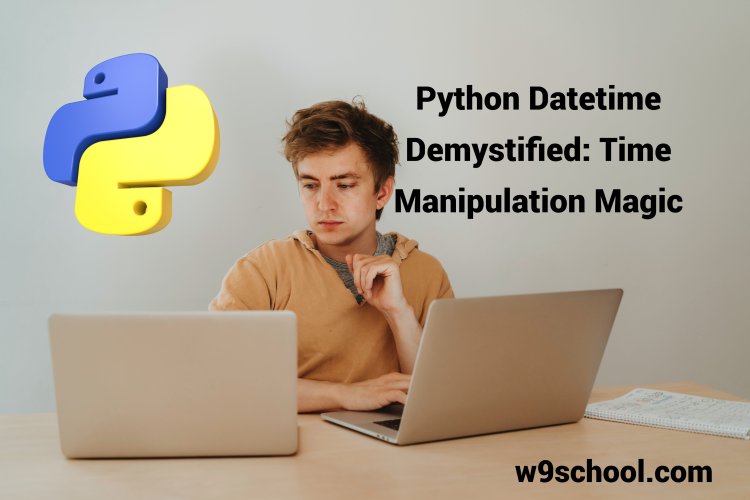Python Datetime Demystified: Time Manipulation Magic
Dive into the world of Python Datetime with our comprehensive guide. Unlock the secrets of time manipulation and formats.

Python Datetime |
Python DatesDates is a date in Python does not have a type of data on its own; however, you can use a program called Example Import the datetime module, and show today's date: Date OutputIf we run the code in the previous example, the outcome will be:
The date is comprised of the year day, month and hour. It also includes minute and minute. Second and microseconds. The Here are some examples. You'll be able to learn more about them during this chapter. Example Enter the year and name of a weekday: Creating Date ObjectsTo make a date we can make use of datetime(), which is the Datetime() is a class that Example Create an object for a date: It is also possible to use the |
The strftime() Method |
|
This The method is known as Example Name the month: A list of all the legal format codes:
|
Working With Dates With the Python Datetime Module |
|
Working with dates is a common aspect of software development, and Python's datetime module makes this task straightforward and accurate. The DateTime module provides various complex functionalities with dates, timezones, timedelta and ISO 8601 dates formats. Additionally, this class helps manage ISO date formats which is very helpful in large projects.
DateWorking with dates can be one of the more complex parts of any programming project. Navigating through various date formats, daylight saving time adjustments and other variables can be challenging to manage, yet thanks to Python datetime module it provides you with many useful functions for this purpose in your projects. The Datetime module contains classes designed to help you manipulate dates and times, perform date-time arithmetic, manage calendars and convert various date/time formats into Python format. A date object, an instance of Datetime class represents dates as years months days; one date object consists of year month day combination. Datetime module also offers time objects, which are instances of the time class. A time object comprises hours, minutes, seconds, microseconds and fold times as well as an attribute representing local time zone information and methods for converting dates and times between ISO 8601 formats and others. Timedelta, part of the datetime module, can help compare two dates or times by taking in duration as input and returning their difference as output. Importantly, it should be remembered that the timedelta function does not take leap years into account when comparing months like February and July using this function - meaning its values may differ due to leap years. Fromordinal is another datetime function that can help convert dates. It takes in a date and returns its proleptic Gregorian ordinal, making this ideal for database storage; using fromordinal means avoiding strftime format strings when formatting dates. The datetime module provides several methods that can be used to obtain information regarding the current timezone and daylight saving time. Current implementations of datetime's datetime module only support one implementation called tzinfo, and don't support switching from daylight saving time to standard time. Python 3.9 includes an improved implementation of tzinfo that makes working with datetime even more useful. Before then, it may be easier to use the dateutil library for retrieving this information. Furthermore, datetime contains numerous methods for converting between time zones, making it an essential component when working with dates and times in Python projects. By having these tools at your disposal it will make navigating dates and times much simpler! TimeThe Time Module contains classes and functions for working with dates, timestamps and time-related functions. It offers an impressive variety of functionality useful in any program: parsing strings for date values; converting between different date/time formats; handling timedelta objects; and displaying calendars. This module can especially come in handy when working with user input as it will validate dates/times to ensure accurate information without errors or discrepancies. In addition to date and time classes, the time module also contains tzinfo class which represents local time zone information of a system and used by localtime() and gmtime() functions to return time objects with current local datetime plus or minus any time zone offset values. Though the tzinfo class provides date and time calculations, its primary function is efficient attribute extraction for output formatting or use with datetime.format() functions. Time objects are data structures containing an integer representing seconds since the epoch and an attribute for local time zone information. They can be created using either the constructor, datetime.fromisoformat() function, or formatted string such as using the %y format code where values 69-99 represent 1969-1999 and 2000-2068 is indicated respectively. The time module offers support for the ISO 8601 standard of dates, along with formats that make conversion easy. A string representing dates using these formats is generally readable across languages and parsable by Python's strptime() function easily. Developers frequently require the ability to convert local time to UTC and store it for later reference, especially when banking transactions need to be stored and converted correctly according to daylight savings time. Programmers typically understand the significance of using the POSIX timestamp representation of dates in their programming; this enables unambiguous comparison between dates and allows programs to validate user input by checking for valid date/time values. But many developers may not realize that time module offers several alternative representations which may help resolve any ambiguities between dates/times values in some situations. |
For more information, Please visit Home
What's Your Reaction?





















